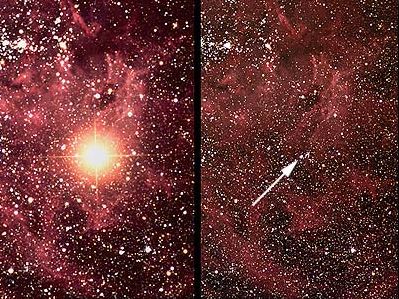Type II Supernova

Credit: David Malin, Anglo-Australian Observatory
Recognised as a distinct type of supernova in the early 1940s, Type II (SNII) are characterised by hydrogen emission in their spectra, and light curve shapes that differ significantly from those of Type I supernovae. SNII are sub-classified depending on whether their light curves show a linear decline after maximum (SNII-L) or a plateau phase (SNII-P) where the brightness remains constant for an extended period of time. The peak brightness of all SNII is several magnitudes fainter than that of a Type Ia supernova (SNIa), but while SNII-P show a large dispersion in their maximum brightness, the peak brightnesses of SNII-L are nearly uniform at 2.5 magnitudes fainter than a SNIa.
Like Type Ib and Type Ic supernovae, SNII are only found in regions of star formation, indicating that they result from the core-collapse of massive stars. The key difference between the three types of core-collapse supernovae is whether they have retained their outer envelopes of hydrogen and helium gas prior to the explosion. The progenitors of SNII have retained both their hydrogen and helium layers, the progenitors of Type Ib supernovae (SNIb) have lost the hydrogen envelope but retain a helium envelope, and progenitors of Type Ic supernovae (SNIc) have lost both the hydrogen and helium envelopes before the core-collapse. Further evidence of a common origin for SNII and SNIb results from observations which show that a very small fraction of SNII turn into SNIb at late times.
Unlike SNIa where nothing remains after the explosion, SNII tend to form supernova remnants of ejected stellar material which surround either a neutron star or pulsar (if the core mass is less than about 3 solar masses), or a black hole. The ejected material is rich in heavy elements synthesised during the explosion making SNII one of the principal sources for heavy elements in the Universe.
Study Astronomy Online at Swinburne University
All material is © Swinburne University of Technology except where indicated.

